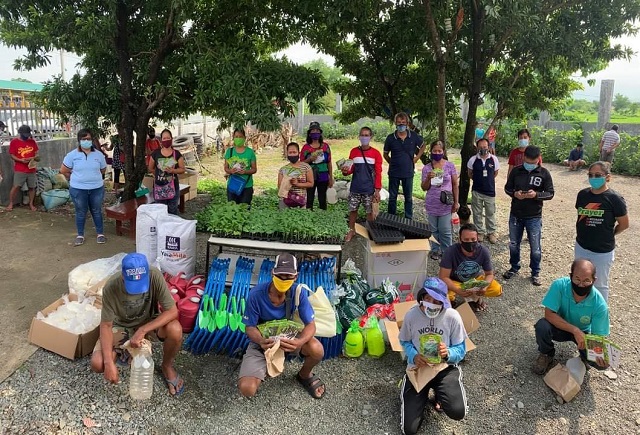John C. De Leon, PhD
Executive Director, DA-PhilRice

The “Sa Palay at Gulay, may Ani, Hanapbuhay, Oportunidad, at Nutrisyon” or PAG-AHON Project, which aims to boost food production in Lupao, Nueva Ecija, is one of the Institute’s initiatives on partnership to help communities survive some of the challenges brought about by the COVID-19 pandemic. PAG-AHON is implemented with the local government of Lupao, Nueva Ecija, Lupao Vegetable Growers Association, and EastWest Seed Company. It is part of the DA’s Plant, Plant, Plant program.
RESEARCH AND DEVELOPMENT (R&D)
The context of R&D as the harbinger of ‘new normal’ is not an overstatement or an adaptation to the COVID-19- induced turn of events. Research for Development encapsulates it better, suggesting progress and broader impacts with the spread of new technologies – making our normal way of life better.
The protracted battle with the coronavirus disease (COVID-19) defines the ‘new normal’ in the context of varying strictness of community quarantine levels in order for governments to contain public health challenges. And suddenly, common-fare R&D practices especially in laboratories, such as the use of face masks (the surgical type), the frequent washing of hands with soap, the use of hand sanitizers, disinfection with alcohol or the use of other chemical disinfectants, among others, became widespread and normal. Also, compliance with physical distancing admonitions while conducting or visiting experiments is not hard to achieve in vast and open agricultural fields.
Even under the state of national health emergency, thus, opinions that we are not going back to normal are controverted by careful thoughts that there is nothing new about the ‘new Expert’s Corner JOHN C. DE LEON, PhD Executive Director, DA-PhilRice Coping with the ‘new normal’ normal.’ The World Health Organization says that living with the coronavirus will be part of the ‘new normal’ going ahead. But in our ‘previous normal’, we were also exposed to many contaminants, bacteria, viruses, microbes, and germs going to work and doing daily routines – including R&D.
The work environment is still abnormal and unpredictable. It has also become more complicated with new learnings. As food workers, our line of sight should not only see increasing production along the whole value chain. To build resilience, our food system’s interconnectedness with health, economy, ecosystems, and other sectors or systems must be recognized. A recent report by the Committee on World Food Security of the Food and Agriculture Organization also found that more pillars are needed for a truly secure food system. Sustainability and agency (or the ability of people to engage with food systems on their own terms) must now be added to the four current pillars of availability, access, utilization, and stability to be effective.
The COVID-19 pandemic and its ‘new normal’ aftermath has not blurred our vision at PhilRice for a rice-secure Philippines. It deepened instead our understanding of another intersystem linkage – that of food security with national security. Our R&D is determined, thus, to contribute to both. •
SURVIVE, REBOOT, GROW: FOOD AND AGRICULTURE’S PREEMINENCE
The lockdowns that quickly happened to derail the novel coronavirus and its pandemic’s geographical spread inadvertently slowed down the national economy. In fact, our GDP contracted by 0.2 percent in Q1 this year. The agriculture and industry sectors respectively declined by 0.4 and 3.0 percent. Under a sudden state of national emergency, ‘stay at home’ became a mantra along with the ‘World War C is not over’ reminder. The DA leadership meanwhile rallied everyone under its fold to hold the agriculture fort together and cause it to ‘survive, reboot, and grow’ as the times become better.
The COVID-19 pestilence has underscored many things, including the preeminence of food and agriculture in our society. To a large extent, survival became synonymous with not getting infected with the virus and with having enough food to nourish the body, battle the disease, and sustain one’s self and family during the lockdowns. Here, the centrality of rice as a consumer commodity became clear again in the preparation and distribution of relief goods and food packs all over the country. Still, we need not lose sight of a whole value chain approach to render for a whole-of-the nation outcome.
The easing up of community quarantines to more liberal levels (General Community Quarantine [GCQ], Modified GCQ) in many places in the country is a signal that the process of renewal (reboot) has taken place. We should be ready now to pursue with vigor the stalled growth of agriculture’s ‘Ani at Kita’ to pump up the economy. We certainly hope that overall rice harvests will show growth this year, or at least indicate increments in per unit-area yields despite the problems on movement and logistics, especially under the Enhanced Community Quarantine (ECQ) and Modified ECQ scenarios. Giving up is not an option though if the desired results do not come about. We may also have to “fight this battle more than once to win it.” •




